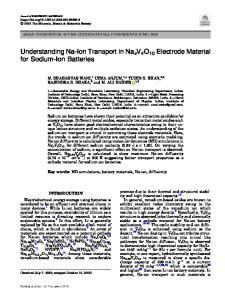Porous Na 3 V 2 (PO 4 ) 3 /C as cathode material for high-rate sodium-ion batteries by sacrificed template method
- PDF / 1,387,755 Bytes
- 8 Pages / 595.276 x 790.866 pts Page_size
- 47 Downloads / 294 Views
ORIGINAL PAPER
Porous Na3V2(PO4)3/C as cathode material for high-rate sodium-ion batteries by sacrificed template method Shuo Bao 1,2 & Ying-ying Huang 1 & Shao-hua Luo 2,3 & Jin-lin Lu 1 Received: 21 March 2020 / Revised: 18 May 2020 / Accepted: 25 May 2020 # Springer-Verlag GmbH Germany, part of Springer Nature 2020
Abstract NASICON-type Na3V2(PO4)3 with a three-dimensional open framework structure has attracted wide attention, and it is regarded as one of the most promising cathode material for sodium-ion batteries. However, the low electronic conductivity restricts its charge–discharge capacity and electrochemical performance. With the purpose to solve this problem, polystyrene microspheres are applied in the preparation of cathode materials for sodium-ion batteries. Particular porous-structured Na3V2(PO4)3 composing of interlaced nanosheets is obtained samples by a simple hydrothermal-assisted sol–gel method via a self-sacrificed template (polystyrene microsphere). As expected, the as-prepared porous sample delivers a reversible capacity of 109.2 mAh g−1 at 0.2 C, an excellent rate performance (89.6 mAh g−1 at 50 C) and superior cyclic stability (retention of 94% over 500 cycles at 50 C). The outstanding rate and cyclic performance are attributed to its unique porous structure which is conducive to improve electron conductivity and facilitate the diffusion of sodium ions. Keywords Na3V2(PO4)3 . Self-sacrificed template . Sodium-ion batteries . Rate performance
Introduction It is common knowledge that lithium-ion batteries (LIBs) are gradually mature in the applications of energy storage because of the large energy capacity and high safety. LIBs have become the most promising rechargeable batteries during the past few decades [1, 2]. However, LIBs are suffering from less distribution of lithium and increasing prices which restrict its applications in large grid-level storage [3, 4]. Recently, sodium-ion batteries (SIBs) have attracted extensive attention Electronic supplementary material The online version of this article (https://doi.org/10.1007/s11581-020-03635-0) contains supplementary material, which is available to authorized users. * Shao-hua Luo [email protected] * Jin-lin Lu [email protected] 1
School of Materials and Metallurgy, University of Science and Technology Liaoning, Anshan 114051, People’s Republic of China
2
Key Laboratory of Dielectric and Electrolyte Functional Material Hebei Province, Qinhuangdao, People’s Republic of China
3
School of Resources and Materials, Northeastern University at Qinhuangdao, Qinhuangdao 066004, People’s Republic of China
due to their abundant reserves and low cost. Meanwhile, as sodium and lithium belong to the same main group, so they have similar chemical properties. However, there are still several non-negligible problems with SIBs compared with LIBs. The sodium ions with larger ion radius (1.02 Å) cannot easily insert into/extract from the crystal structure of the cathode materials, and the relatively large volume change caused by the de-intercala
Data Loading...










